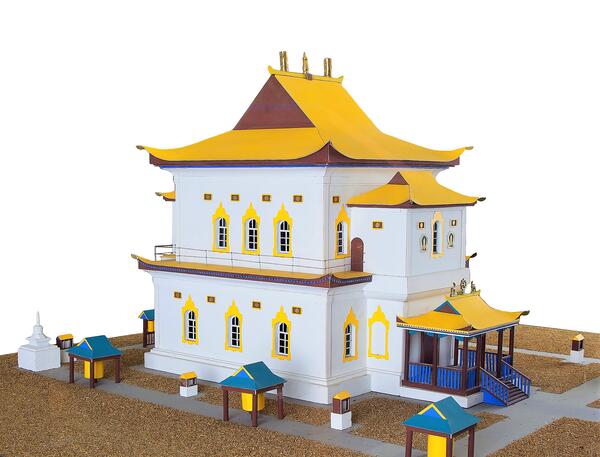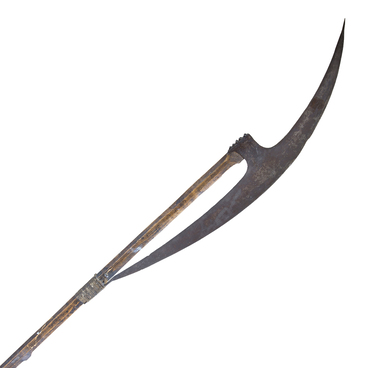The Transbaikal Regional Museum of Local Lore houses a miniature model of the Aginsky datsan — a Buddhist monastery located in the village of Amitkhasha, Zabaykalsky Krai. It was named after the Aga River, located nearby.
In 1811, several Buryat families invited the taisha — the elder — Galsan Markhaev to choose a place where a new datsan should be built. According to a legend, at night he had a dream with the sounds of a moleben, laughter of monastery students, and dogs barking nearby. The taisha considered this a sign and chose the Bulaktui area for the datsan.
Russian stonemasons and carpenters were invited to build the datsan. They had already built Buddhist monasteries before, but mostly worked on Russian churches. That is why the architecture of the first datsan combined features of Tibetan models and Russian church architecture. The datsan was opened in 1816.
In the following decades, the monastery’s infrastructure developed further. In the 1860s, a Tsannid school was opened on the territory — a philosophical department for future lamas, as well as a monastery printing house. It became the center of publishing activity in Transbaikalia.
In the Aginsky datsan they printed educational literature on theological disciplines: philosophy, logic, astronomy, astrology, tantrism, and medicine, as well as ritual texts, Tibetan-Mongol dictionaries, and grammar books. The monastery became well-known in Central Asia thanks to these printing activities.
After the revolution, the Soviet government began to carry out anti-religious propaganda, including against Buddhism. In the late 1930s, the datsan was closed, ritual utensils and Buddhist artworks were sent to museums in Moscow, Leningrad and Ulan-Ude.
In 1940, a military base was located on the territory of the monastery. After the Great Patriotic War, in 1946, the Aginsky Datsan was reopened to visitors and students.
In 1990, at the request of the residents of the Agin-Buryat Autonomous Okrug, the datsan was allowed to take back its former building. A statue of Maidari and about 250 religious items that belonged to the monastery before the revolution were transferred from St. Petersburg.
In 1991, the 14th Dalai Lama Tenzin Gyatso visited and consecrated the datsan. Two years later, a spiritual educational institution was opened on the territory — the Aginsky Buddhist Academy.
In 1811, several Buryat families invited the taisha — the elder — Galsan Markhaev to choose a place where a new datsan should be built. According to a legend, at night he had a dream with the sounds of a moleben, laughter of monastery students, and dogs barking nearby. The taisha considered this a sign and chose the Bulaktui area for the datsan.
Russian stonemasons and carpenters were invited to build the datsan. They had already built Buddhist monasteries before, but mostly worked on Russian churches. That is why the architecture of the first datsan combined features of Tibetan models and Russian church architecture. The datsan was opened in 1816.
In the following decades, the monastery’s infrastructure developed further. In the 1860s, a Tsannid school was opened on the territory — a philosophical department for future lamas, as well as a monastery printing house. It became the center of publishing activity in Transbaikalia.
In the Aginsky datsan they printed educational literature on theological disciplines: philosophy, logic, astronomy, astrology, tantrism, and medicine, as well as ritual texts, Tibetan-Mongol dictionaries, and grammar books. The monastery became well-known in Central Asia thanks to these printing activities.
After the revolution, the Soviet government began to carry out anti-religious propaganda, including against Buddhism. In the late 1930s, the datsan was closed, ritual utensils and Buddhist artworks were sent to museums in Moscow, Leningrad and Ulan-Ude.
In 1940, a military base was located on the territory of the monastery. After the Great Patriotic War, in 1946, the Aginsky Datsan was reopened to visitors and students.
In 1990, at the request of the residents of the Agin-Buryat Autonomous Okrug, the datsan was allowed to take back its former building. A statue of Maidari and about 250 religious items that belonged to the monastery before the revolution were transferred from St. Petersburg.
In 1991, the 14th Dalai Lama Tenzin Gyatso visited and consecrated the datsan. Two years later, a spiritual educational institution was opened on the territory — the Aginsky Buddhist Academy.


